- Regulatory Status
- RUO
- Other Names
- Gelatinase B, Type IV collagenase, MMP
- Ave. Rating
- Submit a Review
- Product Citations
- publications
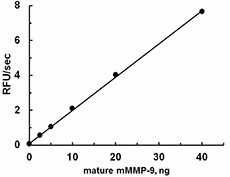
-
The activity of Mouse MMP-9 (Gelatinase B) was measured with 10 µM of fluorogenic MMP substrate, Mca-PLGLDpa-AR, in the presence of 2.5, 5, 10, 20, and 40 ng of activated mouse MMP-9.
| Cat # | Size | Price | Quantity Check Availability | Save | ||
|---|---|---|---|---|---|---|
| 755202 | 10 µg | 175€ | ||||
| 755204 | 25 µg | 306€ | ||||
Matrix metalloproteinases-9, also known as MMP-9, is a member of the matrix metalloproteinase family. Members of this family are structurally related, zinc-containing enzymes that degrade the extracellular matrix (ECM) and connective tissue proteins. Proteolytic activities of MMPs play an important role in vascular remodeling, cellular migration, and the processing of ECM proteins and adhesion molecules. MMP-9 consists of a prodomain, catalytic domain, hinge region, and hemopexin domain. MMP-9 is secreted as an inactive zymogen that becomes activated extracellularly. The most relevant natural activators of proMMP-9 are unknown. MMP-9 activation may be mediated by the removal of the prodomain by serine proteases or other MMPs, or it may be a direct response to oxidative stress, which disrupts the cysteine switch. MMP-9 is capable of processing cytokines and chemokines. For example, it is reported to release the biologically active form of vascular endothelial growth factor (VEGF), indicating that MMP-9 may play a crucial role in the formation of new blood vessels. MMP-9 participates in the migration of immune cells as demonstrated by MMP-9 knockout mice after the antigen challenge. Increased MMP-9 expression and activity has been observed to be related to various cancers, as it may contribute to the release of metastatic cells from the bulk tumor as well as their entrance at the site of metastasis by degrading proteins in the ECM and basement membrane.
Product DetailsProduct Details
- Source
- Mouse MMP-9, amino acids (Ala20-Pro730) (Accession# P41245) with C-terminal TG-8His-GGQ tag was expressed in 293E cells.
- Molecular Mass
- The 724 amino acid recombinant protein has a predicted molecular mass of approximately 80.0 kD. The DTT-reduced and non-reduced protein migrates at appoximately 90-110 kD by SDS-PAGE.
- Purity
- >95%, as determined by Coomassie stained SDS-PAGE.
- Formulation
- 0.22 µm filtered protein solution is in TCN (25 mM TRIS, 10 mM CaCl2, 150 mM NaCl, and in pH 7.5).
- Endotoxin Level
- Less than 1.0 EU per µg of protein as determined by the LAL method.
- Concentration
- 10 and 25 µg sizes are bottled at 200 µg/mL.
- Storage & Handling
- Unopened vial can be stored at -20°C or -70°C for six months. For maximum results, quick spin vial prior to opening. Avoid repeated freeze/thaw cycles.
- Activity
- Mouse MMP-9 cleaves the peptide substrate Mca-PLGL(Dpa)AR with a specific activity value higher than 1,000 pmol/µg/min after activation.
- Application
-
Bioassay
- Application Notes
-
This protein is in the latent form and needs to be activated for bioassay.
BioLegend carrier-free recombinant proteins provided in liquid format are shipped on blue-ice. Our comparison testing data indicates that when handled and stored as recommended, the liquid format has equal or better stability and shelf-life compared to commercially available lyophilized proteins after reconstitution. Our liquid proteins are verified in-house to maintain activity after shipping on blue ice and are backed by our 100% satisfaction guarantee. If you have any concerns, contact us at tech@biolegend.com. - Product Citations
-
Antigen Details
- Structure
- Monomer.
- Distribution
-
Normal alveolar macrophages, granulocytes, and osteoclast lineage.
- Function
- Angiogenesis, tissue remodeling, and cancer metastasis.
- Interaction
- Macrophages and neutrophils.
- Ligand/Receptor
- TIMPs.
- Biology Area
- Angiogenesis, Cell Adhesion, Cell Biology, Neuroinflammation, Neuroscience, Stem Cells
- Molecular Family
- Enzymes and Regulators
- Antigen References
-
1. Chakrabarti S, Patel KD. 2005. Exp. Lung Res. 6:599-621.
2. Klein T, Bischoff R. 2011. Amino Acids 41:271.
3. Raffetto JD, Khalil RA. 2008. Biochem. Pharmacol. 75:346.
4. Bourboulia D, Stetler-Stevenson WG. 2010. Semin. Cancer Biol. 20:161.
5. Vilen ST, et al. 2013. Scientific World Journal 2013:920595. - Gene ID
- 17395 View all products for this Gene ID
- UniProt
- View information about MMP-9 on UniProt.org
Related FAQs
- Why choose BioLegend recombinant proteins?
-
• Each lot of product is quality-tested for bioactivity as indicated on the data sheet.
• Greater than 95% Purity or higher, tested on every lot of product.
• 100% Satisfaction Guarantee for quality performance, stability, and consistency.
• Ready-to-use liquid format saves time and reduces challenges associated with reconstitution.
• Bulk and customization available. Contact us.
• Learn more about our Recombinant Proteins. - How does the activity of your recombinant proteins compare to competitors?
-
We quality control each and every lot of recombinant protein. Not only do we check its bioactivity, but we also compare it against other commercially available recombinant proteins. We make sure each recombinant protein’s activity is at least as good as or better than the competition’s. In order to provide you with the best possible product, we ensure that our testing process is rigorous and thorough. If you’re curious and eager to make the switch to BioLegend recombinants, contact your sales representative today!
- What is the specific activity or ED50 of my recombinant protein?
-
The specific activity range of the protein is indicated on the product datasheets. Because the exact activity values on a per unit basis can largely fluctuate depending on a number of factors, including the nature of the assay, cell density, age of cells/passage number, culture media used, and end user technique, the specific activity is best defined as a range and we guarantee the specific activity of all our lots will be within the range indicated on the datasheet. Please note this only applies to recombinants labeled for use in bioassays. ELISA standard recombinant proteins are not recommended for bioassay usage as they are not tested for these applications.
- Have your recombinants been tested for stability?
-
Our testing shows that the recombinant proteins are able to withstand room temperature for a week without losing activity. In addition the recombinant proteins were also found to withstand four cycles of freeze and thaw without losing activity.
- Does specific activity of a recombinant protein vary between lots?
-
Specific activity will vary for each lot and for the type of experiment that is done to validate it, but all passed lots will have activity within the established ED50 range for the product and we guarantee that our products will have lot-to-lot consistency. Please conduct an experiment-specific validation to find the optimal ED50 for your system.
- How do you convert activity as an ED50 in ng/ml to a specific activity in Units/mg?
-
Use formula Specific activity (Units/mg) = 10^6/ ED50 (ng/mL)

 Login / Register
Login / Register 






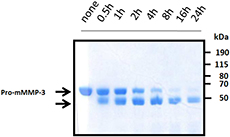
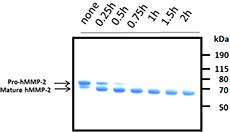
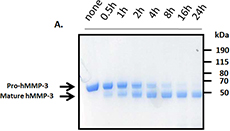
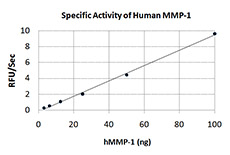



Follow Us